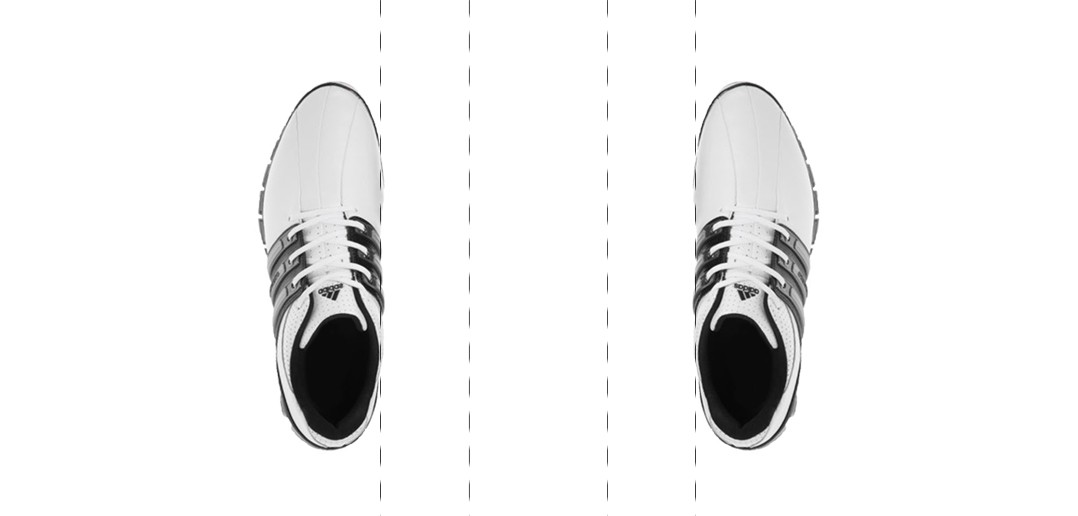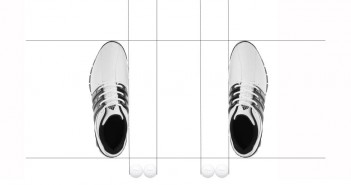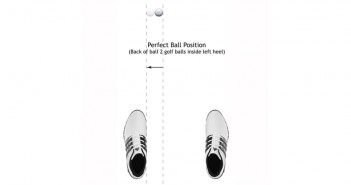The purpose of your stance is to provide a solid foundation upon which to rotate your body. Proper stance width is vital for power, accuracy, consistency and injury prevention.
You may feel that instruction on golf setup is tedious, but, as we’ll discuss here, correct setup is vital for enabling proper movement in the golf swing. The number 1 cause of a faulty golf swing is poor setup. What’s more, it’s the one thing that, with a little practice, you can get 100% correct every time, and so be sure to increase your chances of success with every shot.
There is a lot of conflicting instruction on the correct stance width for the golf swing, most of it is misleading and some of it can be harmful.
Coming into impact, there are enormous forces being generated, especially on the left side of your body. If your joints are misaligned this will lead to discomfort, wear and tear of your joints, and various potential injuries to your back, hip, and knee. These injuries can be avoided by using your body correctly, starting with proper stance width.
Feet Shoulder Width Apart?
Most conventional golf wisdom says that the stance should be shoulder width, or even wider.
When you think about it, what has the width of your shoulders got to do with ideal stance width? Are your legs attached directly to your shoulders? No. If you’re tall and have narrow shoulders do you need a narrower stance? Of course not.
In the Swing like a Champion System, we base the correct stance width on anatomy and on what we’re trying to achieve in the golf swing.
Factors Determining Stance Width
The key determining factor for stance width is the position of your hip joints.
Your legs, the limbs that form your stance width, are attached to your body at the hip joints.
Your stance needs to provide adequate stability, if it’s too narrow you won’t have a stable foundation for the golf swing as you rotate back and through.
Most importantly of all, your stance needs to facilitate the proper sequence of movement, the optimal use of your big muscles, and the correct position of your body through impact.
The Perfect Golf Stance Width
The biomechanically perfect stance width for the full golf swing is when the centre of each ankle is the width of 2 golf balls wider than the hip joints.
Figure 1. Perfect Golf Stance Width
This is the widest the stance can be in order to prevent lateral head movement from occurring throughout the golf swing, while still allowing for a proper weight transfer.
It gives you a wide, stable foundation that enables you to shift your weight without forcing your upper body to shift laterally.
You will be able to shift your weight properly in the backswing, and then easily shift back to the left in the downswing, aligning your joints properly and pivoting around your left hip through impact, and rotating efficiently through impact into the follow-through while staying in balance.
Note that we refer to the hip joint, not the flesh of the hips. The hip joint, as discussed in Golf Swing 101. Setup: Basic Posture, is much closer to the midline of the body than most of us realise — it is deep inside the body, about 2 finger-widths inside the crest of the hip bone when viewed from face-on.
This stance width is constant for any standard full swing shot.
You don’t alter your stance width based on the length of the club. The movement pattern, in terms of weight shift and impact alignment, required for every standard full swing shot is the same.
For speciality shots, such as the driver, chip shots, sand-play etc., stance width will be adjusted. This will be discussed in the relevant sections of this site.
In order to understand why the perfect stance width is as we describe, you need to be aware of a few key concepts in the golf swing. These concepts refer to advanced topics, and if they seem complicated right now then don’t panic, they will all be made abundantly clear in the coming articles and drills.
Club Head Speed
The first concept that you need to be aware of is club head speed.
The concept of power is one of the most misunderstood, and often wrongly taught, aspects of the golf swing. To hit the golf ball a long way, you need to get the club head moving as fast as possible through impact. Generating club head speed does not require the same sort of movement as throwing a punch, swinging an axe, or even swinging a baseball bat, where you need raw muscular power, with your weight behind it.
Imagine a small ball on the end of a string, which is attached to the end of a pencil, and you’re holding the other end of the pencil. When you swing the ball around the pencil, if you want to swing the ball as fast as you possibly can, then your fingers need to make a very small, tightly centred, rotational movement, constantly feeling for and pulling against the weight of the ball. You use centripetal force to accelerate the ball, pulling it towards the centre, not linear force pushing on the ball. Though over simplified, this is a great analogy for the golf swing, the ball being the club head, and although the golf club isn’t a string, it behaves much as the string does when the ball is rotating fast.
The golf swing has more in common with swinging our ball on a string than it does with swinging a heavy hammer or even a baseball bat. In baseball, the ball is moving towards you at approaching 100mph, its effective weight is enormous, and to hit it out of the park you need to hit it hard, with your weight behind the bat to stabilise it, thus requiring a wider stance. In golf, the ball isn’t moving, and it weighs just a few ounces. To hit a golf ball 300+ yards you need to hit it with a club head that is moving very fast, and putting your weight behind the shot won’t help.
The best way generate club head speed is not by pushing the club, but by imparting angular momentum and pulling against the weight of the club through impact, just as you do with the ball on the string. You use centripetal force to accelerate the club head, pulling it towards the centre of your rotation, and not linear force pushing on the grip. Just like the ball on the string, it is a tightly centred rotational motion that generates maximum club head speed.
Another great analogy for the golf swing is cracking a whip — where you can get the tip of a whip to break the sound barrier through good timing, and brute-force pushing will just disrupt the timing and slow the whip down to the point where you can’t crack it at all. The whip cracks because you create angular momentum in the handle which is transferred along the length of the whip in an ever decreasing circle. Just like cracking a whip, the golf swing is primarily about transferring momentum along a kinetic chain, so that the club head “cracks” through impact. Muscular effort is required to set the chain in motion, but generating club head speed at the right place in the swing is mostly about timing and sequencing, not brute strength. More of this in future articles.
Impact Alignment
So, to hit the golf ball powerfully, you need maximum club head speed through impact, which means that you need to be rotating quickly and to be tightly centred.
The best way for your body to do that is by rotating around your left hip, with your weight over the left side, and your joints (left ankle, knee, hip and shoulder) vertically aligned through impact. The hip is the joint that is designed for rotation, and your big muscles in your legs and your core are designed to power and stabilise a centred rotation around the hip. This is exactly what we want in the golf swing.
Weight Shift
Weight transfer is inherent in all athletic throwing and hitting movements. It creates some initial momentum, which is quickly turned into angular momentum (rotation), it enables you to push into the ground to leverage the big muscles in your legs, and it and stretches out the big muscles in the left side of your core. All of these things are necessary in order to generate maximum club head speed.
Some small lateral movement of your lower body is desirable at the start of the downswing to facilitate a proper weight shift, but your head must stay centred in order to keep the bottom of your swing arc consistent, and thus strike the ball cleanly and consistently. Good ball-striking becomes increasingly difficult if your head moves off the ball.
Correct stance width is necessary to enable you to transfer your weight effectively without forcing your upper body to shift laterally.
The Problems with a Wide Stance
The most common fault we see with stance width is when it is too wide.
A wide stance is good for bracing yourself against lateral force on your body, or for when you need to be prepared to dive in either direction. Neither of these is particularly useful in the golf swing. You’re certainly not diving or jumping anywhere, quite the opposite, you need stability and to stay centred. And although the momentum of the arms and golf club does generate a lot of centrifugal force, the golf swing is essentially a rotational motion, and the action of the body pulling against the golf club is enough to balance the forces and keep us centred without needing a wide stance.
Sliding
A wide stance means that you need more lateral movement in order to achieve optimal joint alignment through impact — to get over the left side. This makes the weight shift more difficult, encouraging a destabilising slide to the left — with a wide stance you have to move a long way to get back over the left hip. This slide is very difficult to time properly (it’s one of the main causes of a slice), and it saps your swing of power. A slide is also unhealthy and potentially unsafe, as it places a lot of undue stress on the left hip, knee and the lower back.
Timing
The wider your stance, the bigger the shift to the left required, and so the more time it takes and the harder it is to synchronise with the rest of your body.
In trying to shift quickly enough, you’ll probably push off your right side, driving your right hip towards the ball, which will cause you to lose your spine angle and so make it very difficult to strike the ball cleanly and consistently. This push off the right side is also likely to push your left hip joint ahead of your left ankle through impact, which is also very unhealthy and unsafe, as it places a lot of undue stress on the left hip joint. It is this move which, over the years, has caused so many golfers to suffer from severe hip problems.
Lateral movement in itself does nothing to increase club head speed — a tight, centred, rotational movement will enable you to swing the club head at well over 100mph, swaying your body as fast as you can towards the target is negligible compared to that, and swaying will destroy the quality (the tightness) of your rotational movement. Imagine our ball on a string again, moving your fingers in a wider (looser) circle will just slow the ball down and make it move more erratically.
Getting stuck on the right side
A wide stance feels powerful and stable, but one of the key problems for most golfers is that they never get back onto the left side properly in the downswing. They get “stuck” on the right side. Getting your weight fully transferred to the left, getting stabilised and braced on the left hip, glute and ankle, is vital for swinging the golf club effectively.
If you don’t get your weight back to the left properly, then you can’t rotate and use your lower body effectively. You can’t rotate your hips out of the way and pivot around your left side. Your hips become locked into the ground, and you’re forced to use mostly your upper body to swing the club instead of the big muscles in the legs and core.
Moving off the ball
On the backswing, a wide stance will mean that you need to move your head off the ball in order to shift your weight. This movement is an unnecessary variable that adds yet more timing issues and compensations to your swing.
Lateral upper body movement will dramatically affect your balance and your ability to consistently strike the ball cleanly. If your head is forced to move laterally in the backswing then the natural bottom of your swing arc will move with it. You will then need an excessive lateral shift in the downswing, leading to a loss of speed and making it harder to keep the bottom of the swing arc consistent.
Reverse pivot
If you don’t move your head off the ball, the wide stance will mean that you can’t shift your weight properly in the backswing, resulting in power loss and a potentially destructive reverse pivot.
Balance
You need to complete your follow-through in a balanced position over the left leg. An unbalanced finish is a sure sign that you’ve mistimed your swing and that you’ve had to introduce numerous compensations in trying to get your swing back on track. If you’re not balanced, you can’t be consistent. If you’re a great athlete you may get away with it sometimes, but never all of the time.
A stance that is too wide will dramatically affect your balance as you shift or slide too far laterally, move off the ball on the backswing, slide your hip too far left on the downswing, lose your spine angle and introduce numerous compensations in an effort to bring the club back to the ball. Your subconscious efforts to compensate and keep your balance, during a time when you are generating enormous forces, will place a lot of undue stress on your body, causing discomfort, muscle strain and numerous potential injuries.
In the follow-through you can easily see if you’ve not transferred your weight properly because your right foot will be bent by the weight that is still on it. You should have almost all of your weight on your left foot, the tip of your right foot touching the ground only for balance. Having weight on your right foot here will put strain on your back and hip, and show that your swing has not had the full benefit of weight transfer and rotation.
The Problems with a Narrow Stance
A stance that is too narrow is much more preferable to one that is too wide. You may lose some power, but a narrow stance won’t have the same destructive effects on your timing and ball-striking as a wide one.
A narrow stance will discourage an aggressive weight transfer, and so will reduce the stretch in your muscles and the power that they are able to deliver.
A narrow stance will be less stable, forcing you to slow your swing down in order to maintain your balance into the follow-through.
The main sign of a stance that is too narrow is if your right foot is still flat on the ground at impact. As we’ll see later, your right foot should be on the ground, but rolled in onto the inside of the foot at impact, which indicates a proper weight transfer.
We’ll discuss and demonstrate all of these issues in a lot more depth, and provide drills that enable you to perfect the correct movements, in forthcoming articles.
If you have any questions or comments about this or other articles on Golf Loopy, please send us an email.
Next up: Golf Swing 102b – Setup: The Perfect Golf Ball Position.





